engine coolant AUDI Q3 2016 Owners Manual
[x] Cancel search | Manufacturer: AUDI, Model Year: 2016, Model line: Q3, Model: AUDI Q3 2016Pages: 252, PDF Size: 62.81 MB
Page 12 of 252
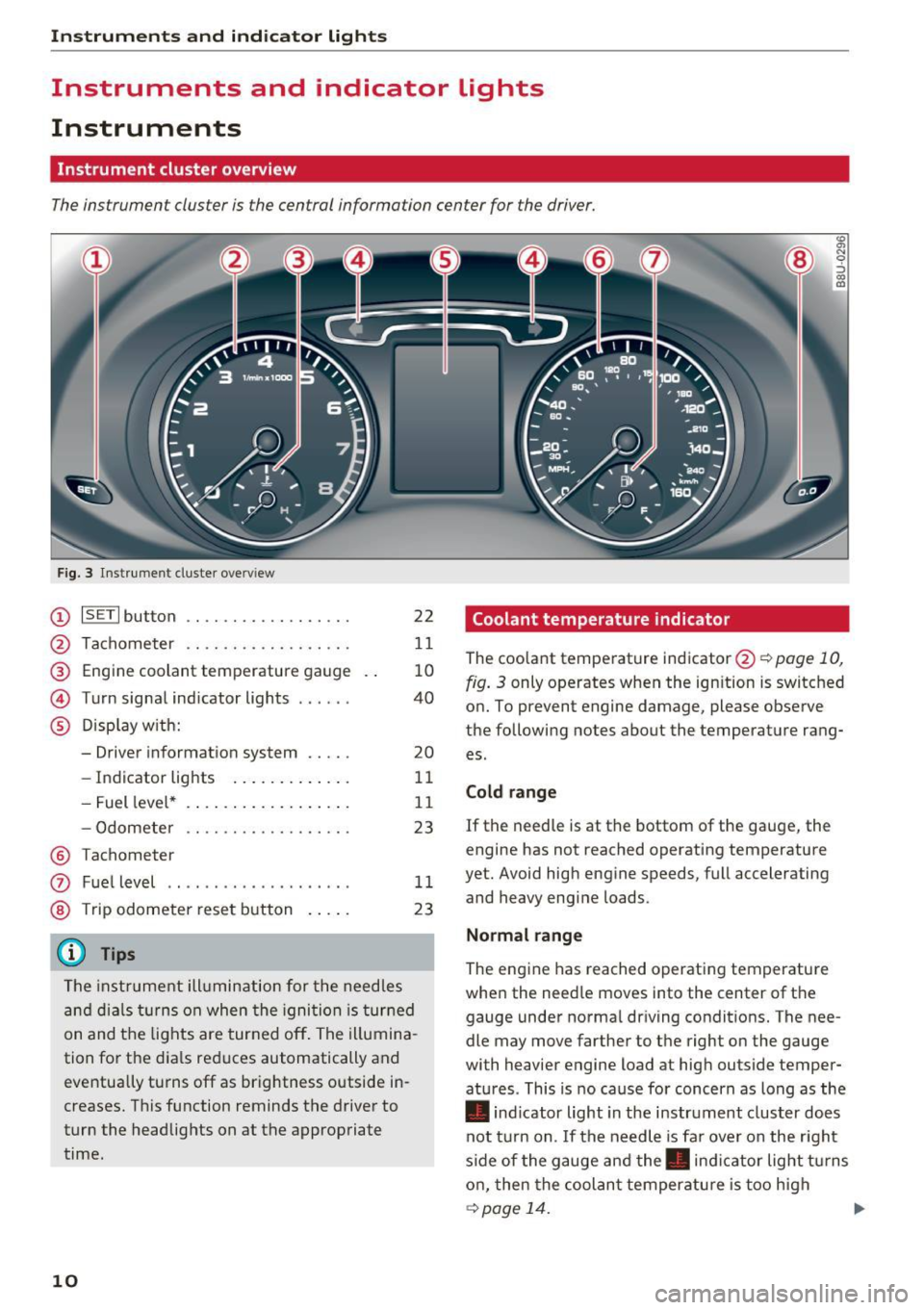
Instrumen ts and ind icator ligh ts
Instruments and indicator Lights
Instruments
Instrument cluster overview
The instrument cluster is the central information center for the driver.
Fig. 3 Instrument cluster overv iew
(D ISETI button .... ........... .. .
@ Tachometer .... .. .. ..... .... .
@ Engine coolant temperature gauge
@ Turn signal ind icator lights ..... .
® Disp lay w ith:
- Driver informat ion system .... .
- Indicator lights .. ..... ... .. .
- Fuel leve l*
- Odometer
® Tachometer
(J) Fue l level .............. ..... -
® Trip odometer reset button
(D Tips
22
11
10
40
20
11
1 1
23
11
23
The instrument ill umination for the needles
and dia ls t urns on when the igni tion is tur ned
on and the lights are tur ned off . The illumina
tion for the dia ls reduces automatically and
eventually turns off as brightness outside in
creases. This function reminds the driver to
turn the headlights on at the appropriate
time.
10
Coolant temperature indicator
"'
"' N
0
;::) a,
"'
The coolant temperature indicator@~ page 10,
fig . 3
only operates when the ign ition is switched
on. To prevent engine damage, please observe
the following notes about the temperature rang
es .
Cold range
If the needle is at the bottom of the gauge, the
engine has not reached operating temperature
yet. Avoid high engine speeds, full accelerating
and heavy engine loads.
Normal rang e
The engine has reached operating temperature
when the needle moves into the center of the
gauge under norma l dr iving condit ions. The nee
dle may move farther to the right on the gauge
with heavier engine load at high outside temper
atures . This is no cause for concern as long as the
• indicator light in the instrument cluster does
not turn on . If the needle is fa r over on the r ight
s ide of the gauge and the . indicator light tu rns
on, then the coolan t temperatu re is too high
~ page 14. ..,.
Page 13 of 252
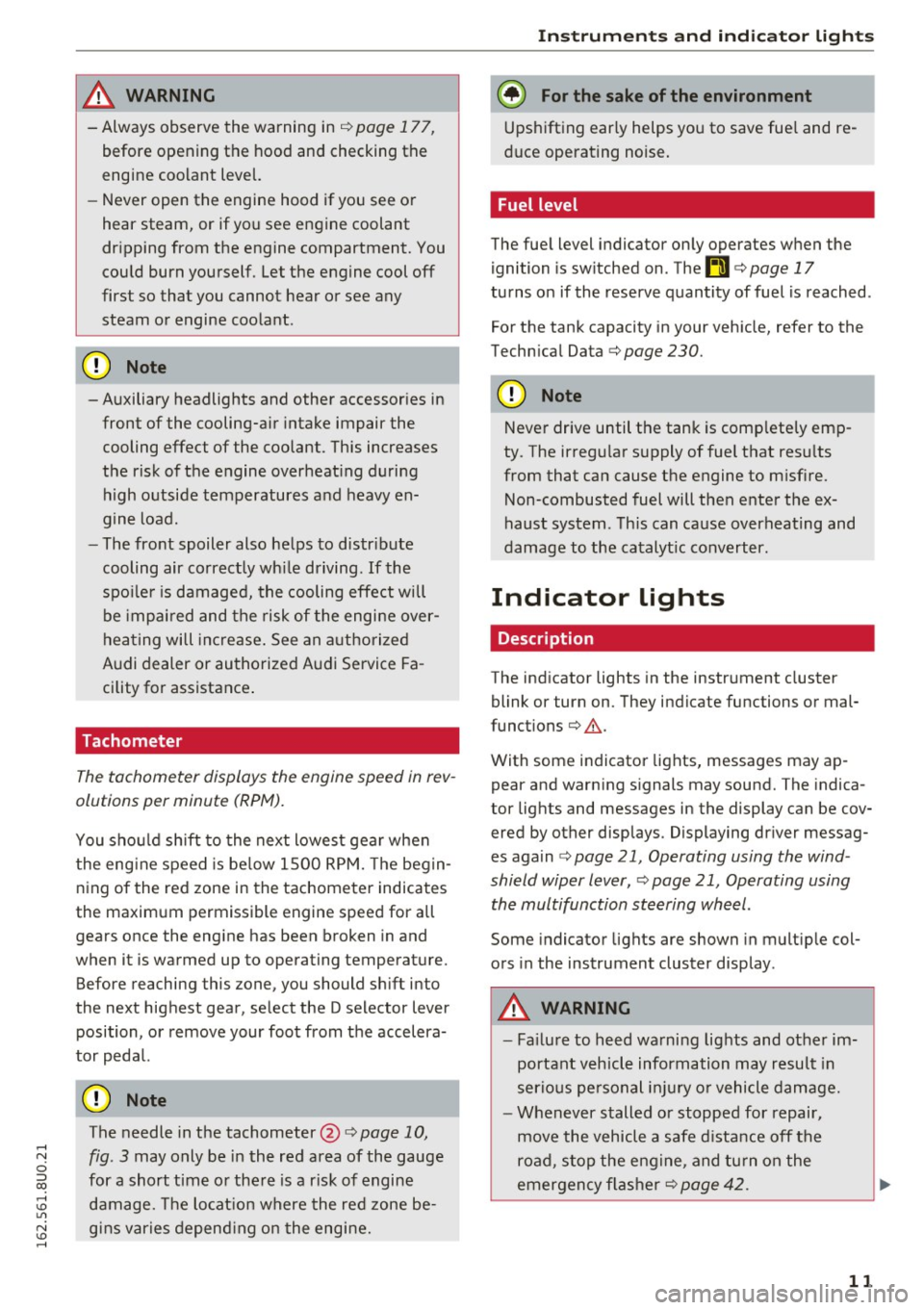
& WARNING
-Always observe the warning in ¢ page 177,
before opening the hood and checking the
engine coolant level.
- Never open the engine hood if you see or
hear steam, or if you see engine coolant
dr ipping from the engine compartment. You
could burn yourself. Let the engine cool off
firstsothatyoucannothearorseeany
steam or engine coolant .
(D Note
-Auxiliary headlights and other accessories in
front of the cooling-air intake impair the
cooling effect of the coolant. This increases
the risk of the engine overheat ing during
high o utside temperatures and heavy en-
gine load.
- The front spoiler also helps to distr ibute
cooling air correctly wh ile driving .
If the
spo ile r i s damaged, the cooling effect will
be impaired and the risk of the engine over
heating will increase . See an a uthorized
Audi dealer or authorized Audi Service Fa
cility for assistance .
Tachometer
The tachometer displays the engine speed in rev
olutions per minute (RPM).
You shou ld sh ift to the next lowest gear when
the eng ine speed is be low 1 500 RPM. The beg in
ning of the red zone in the tachometer indicates
the maximum permissible engine speed for all
gears once the engine has been broken in and
when it is warmed up to operating temperature. Before reaching this zone, you should sh ift into
the next highest gear , select the D selector lever
position, or remove your foot from the accelera
tor pedal.
CT) Note
The needle in the tachometer@¢ page 10,
fig . 3
may only be in the red area of the gauge
for a short time or the re is a r isk of engine
damage. The locat ion where the red zone be
gins varies depend ing on the engine.
In strum ents an d ind ic a to r ligh ts
{® For the sa ke of the en vironment
Upshifting ear ly helps you to save fue l and re
duce operating noise.
Fuel level
The fue l level indicator on ly operates when the
ignition is sw itched on . The
rD ¢ page 17
turns on if the reserve quantity of fuel is reached .
For the tank capacity in your veh icle, refer to the
Techn ica l Data ¢
page 230.
(D Note
Never drive until the tank is comp letely emp
ty. The irregu lar supply of fuel that res ults
from that can cause the engine to m isf ire.
Non-combusted fuel will then enter the ex
haust system . This can cause overheat ing and
damage to the catalyt ic converter.
Indicator lights
Description
The indicator lights in the instrument cluster
blink or turn on. They indicate functions or mal
funct ions¢ .&..
With some indicator lights, messages may ap pear and warning signals may sound. The indica
tor lights and messages in the display can be cov ered by other displays . Displaying driver messag
es again ¢
page 21, Operating using the wind
shield wiper Lever,
¢ page 21, Operating using
the multifunction steering wheel.
Some indicator lights are shown in multip le col
ors in the instrument cluster display.
& WARNING
--
- Fa ilure to heed wa rning lights and other im
portant vehicle information may resu lt in
serio us pe rsonal inj ur y o r vehicle damage.
- Whenever stalled or stopped for repair,
move the vehicle a safe d ista nce off the
road, stop the engine, and tu rn on the
emergency fl ashe r ¢
page 42 .
11
Page 16 of 252
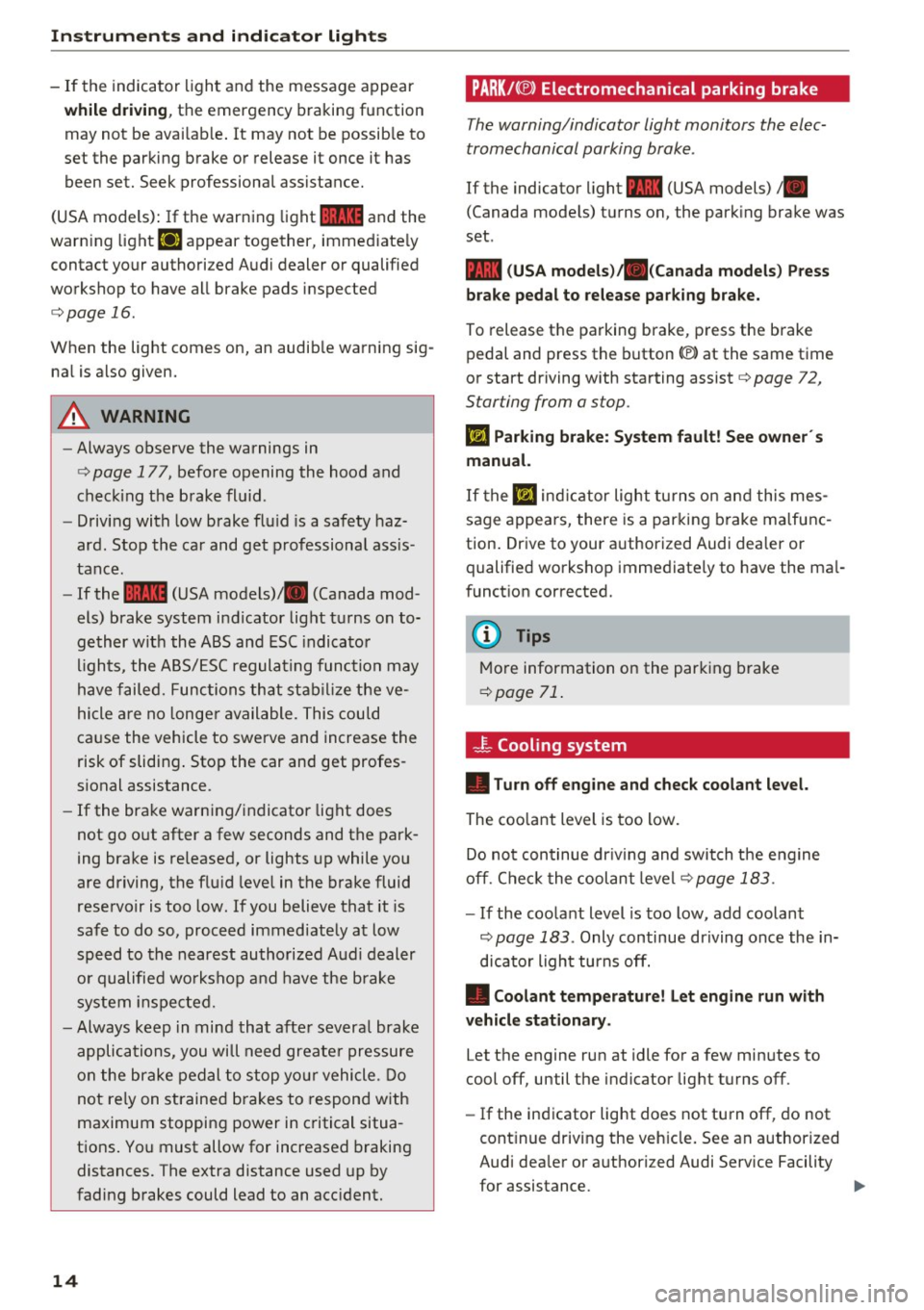
Instruments and indicator lights
-If the indicator light and the message appear
while d riving , the emergency braking function
may not be ava ilab le . It may not be possib le to
set the parking brake or release it once it has been set. Seek professiona l assistance.
(USA models) : If the warning light
1111 and the
warn ing light
[I] appear together, immed iate ly
contact your authori zed Audi dealer or qualified
workshop to have all brake pads inspected
,:::;, page 16.
When the light comes on, an audib le wa rning sig
na l is also given.
A WARNING
- Always observe the warnings in
,:::;, page 177, before opening the hood and
check ing the b rake fl uid .
- Driving with low brake fl uid is a sa fety haz
ar d. Stop the car and get professional ass is
tance.
- If the 1111 (USA models) ;III (Canada mod
els) brake system i ndicator lig ht t urns on to
ge th er wit h the ABS an d ESC indica to r
l igh ts, the ABS/ ESC regulating functi on may
have failed. Func tions tha t st abilize the ve
hicle are no longe r available. This cou ld
ca use the vehicle to swerve and increase the
risk of sliding . Stop the car and get profes
sional assistance .
- If the bra ke warn ing/indicator light does
not go o ut after a few seconds and the park
ing brake is released, or lights up while you
are driving, t he flu id leve l in the brake fluid
rese rvoir is too low. If you believe that it is
safe to do so, proceed immediately a t low
speed to the nearest au thori zed Audi dealer
o r qualifie d works hop and have the brake
sys tem inspe cte d.
- Always keep in min d that afte r sev era l brake
applica tions, you w ill need greate r pressure
on the brake pedal to stop yo ur vehicle. Do
not rely on straine d brakes to respond w ith
ma ximum stopping power in critical situa
t ions . You must allow for increased braking
distances. The extra distance used up by
fading b rakes could lead to an acc ident.
14
PARK!< ®> Electromechanical parking brake
The warning/indicator light monitors the elec
tromechanical parking brake .
If the indicator light - (USA models) ;Ill
(Canada mode ls) tu rns on, the park ing brake was
set .
- (USA models);lll (Canada models) Press
brake pedal to release parking brake.
To release the parking b rake, press the brake
pedal and press the button(®) at the same time
or start driving with starting assist
c::;, page 72,
Starting from a stop.
Ill Parking brake: System fault! See owner 's
manual.
I f the Ill ind ic a tor light turns on and t his mes
sage appea rs, there is a par king bra ke m alfu nc
tion . Drive to your authorized Audi dea ler or
qualified workshop imme diate ly to have the ma l
funct ion corrected.
(D Tips
M ore information on the par king brake
c::;, page 71 .
-F-Cooling system
• Turn off engine and check coolant level.
The coo lant level is too low.
Do not con tinue dr iving and swit ch t he engine
off. Che ck the coolan t l evel
c::;, page 183 .
-If the coo lant level is too low, add coolant
c::;, page 183 . Only continue dr iving once the in
dicato r light turns off.
• Coolant temperature! Let engine run with
vehicle stationary .
Let the engine run at idle fo r a few min utes to
cool off, until the indicator lig ht turns off .
- If the ind icator light does not turn off, do not
cont inue driving the veh icle. See an a uthorized
Audi dea le r or a uthorized Audi Service Facility
for assistance. ..,.
Page 17 of 252
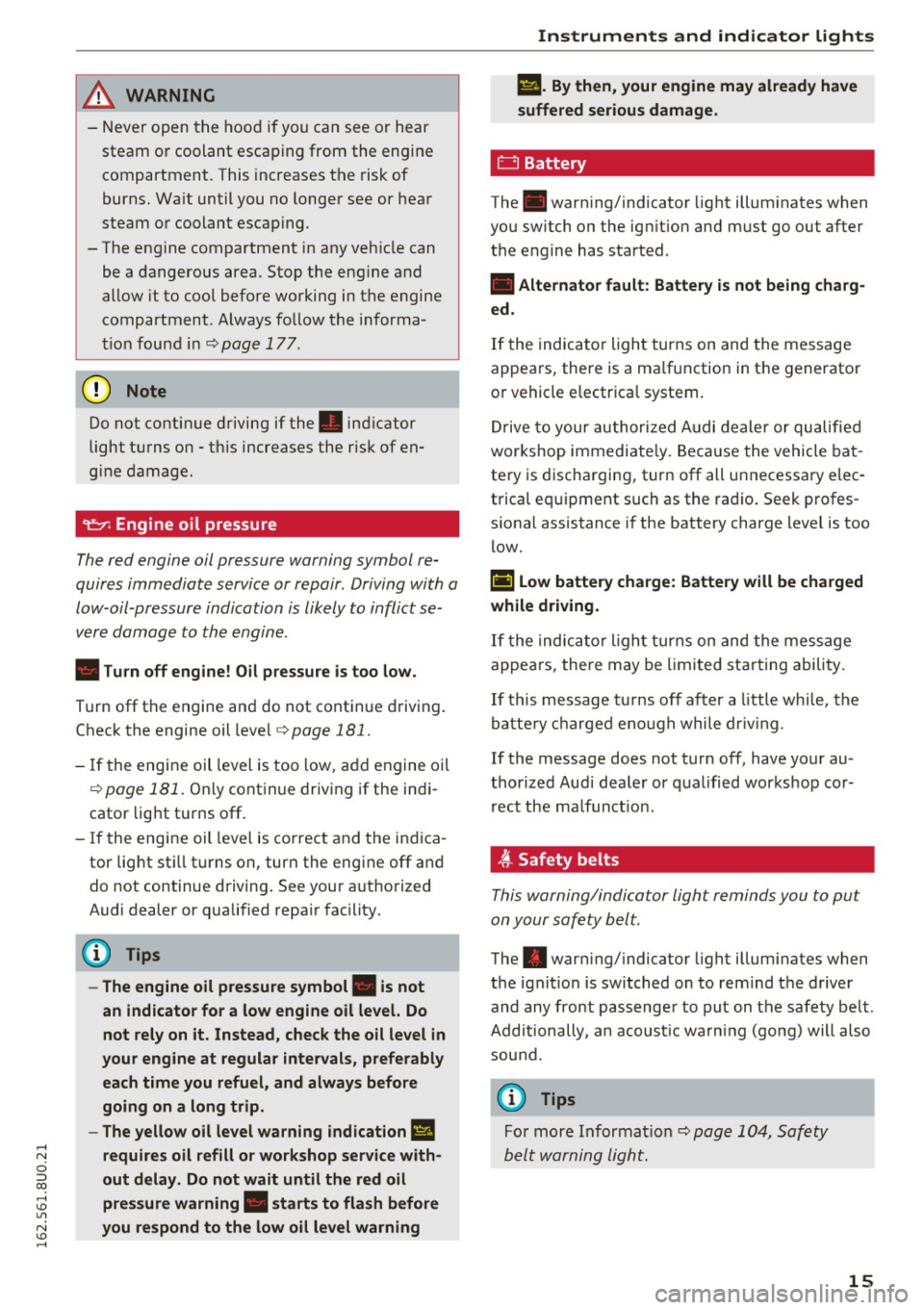
& WARNING
-Never open the hood if you can see or he ar
steam or coolant escaping from the engine
compartment. This inc reases t he risk of
burns . Wa it until you no longe r see or hea r
steam o r coolant escap ing .
- The engine compartment in any veh icle can
be a dangerous area. Stop the eng ine and
allow it to coo l before working in t he engine
compartment . A lways fo llow the informa
ti on foun d in ¢
page 177 .
(D Note
Do not contin ue d riving if the. indicator
light turns o n -thi s increases the r isk of en
gi ne damage.
"t!:r. Engine oil pressure
The red engine oil pressure warning symbol re
quires immediate service or repair . Driving with a
low-oil-pressure indication is likely to inflict se
v e re damage to the engine .
• Turn off engine! Oil pressure is too low.
Tur n off the engine an d do not cont inue d riving .
C hec k the engine oil leve l¢
page 181.
- If the engine oil leve l is too low, a dd engine o il
¢
page 181 . Only cont inue driv ing if the ind i
cator lig ht t urns off.
- If the engine oil leve l is correc t and the i ndica
tor light sti ll tur ns on, turn the eng ine off and
do not continue driving . See you r auth orized
Audi dealer or qualif ied repa ir facility.
@ Tips
-The engine oil pressure symbol. is not
an indicator for a low engine oil level. Do
not rely on it. Instead, check the oil level in
your engine at regular intervals, preferably
each time you refuel, and always before
going on a long trip.
- The yellow oil level warning indication
Ill
requires oil r efill or workshop service with
out delay . Do not wait until the red oil
pressure warning. starts to flash before
you respond to the low oil level warning Instruments and ind
icator lights
IIJ. By then, your engine may already have
suffered serious damage.
0 Battery
The . warn ing/ indicato r light illum inates when
you sw itch on the ig nition and m ust go out after
t h e e ngine has started .
• Alternator fault: Battery is not being charg
ed .
If the indic ator ligh t turns on and the message
appea rs, the re is a ma lfunction in t he generator
o r vehicle e lectr ica l system.
D rive to your au thor ized A udi dealer or qu alified
wor kshop im medi ate ly. Bec au se the vehicle bat
te ry is d ischa rgin g, turn off all u nnecessary elec
t rical eq uipment such as the rad io . Seek p rofes
s iona l assistance if the battery charge level is too
low.
(•) Low battery charge: Battery will be charged
while driving .
If the indic ator ligh t turns on an d the mess age
appea rs, there may be limi ted sta rting abili ty .
If this message turns off after a little whi le, the
ba tte ry ch arge d eno ugh while dr iv ing .
If the message does not turn off, have yo ur au
t h orized Audi de aler or q ual ified works hop cor
r ec t t he ma lf u nct ion.
4t Safety belts
This warning/indicator light reminds you to put
on your safety b elt.
The . war ning/ indicator light illum inates when
t h e ignit io n is switched on to remind t he driver
and any front passenge r to put on the safety be lt.
Addi tionally , a n acous tic w arnin g (go ng) will also
sou nd.
@ Tips
Fo r mor e In forma tion ¢ pag e 104, Saf ety
bel t warning light .
15
Page 70 of 252
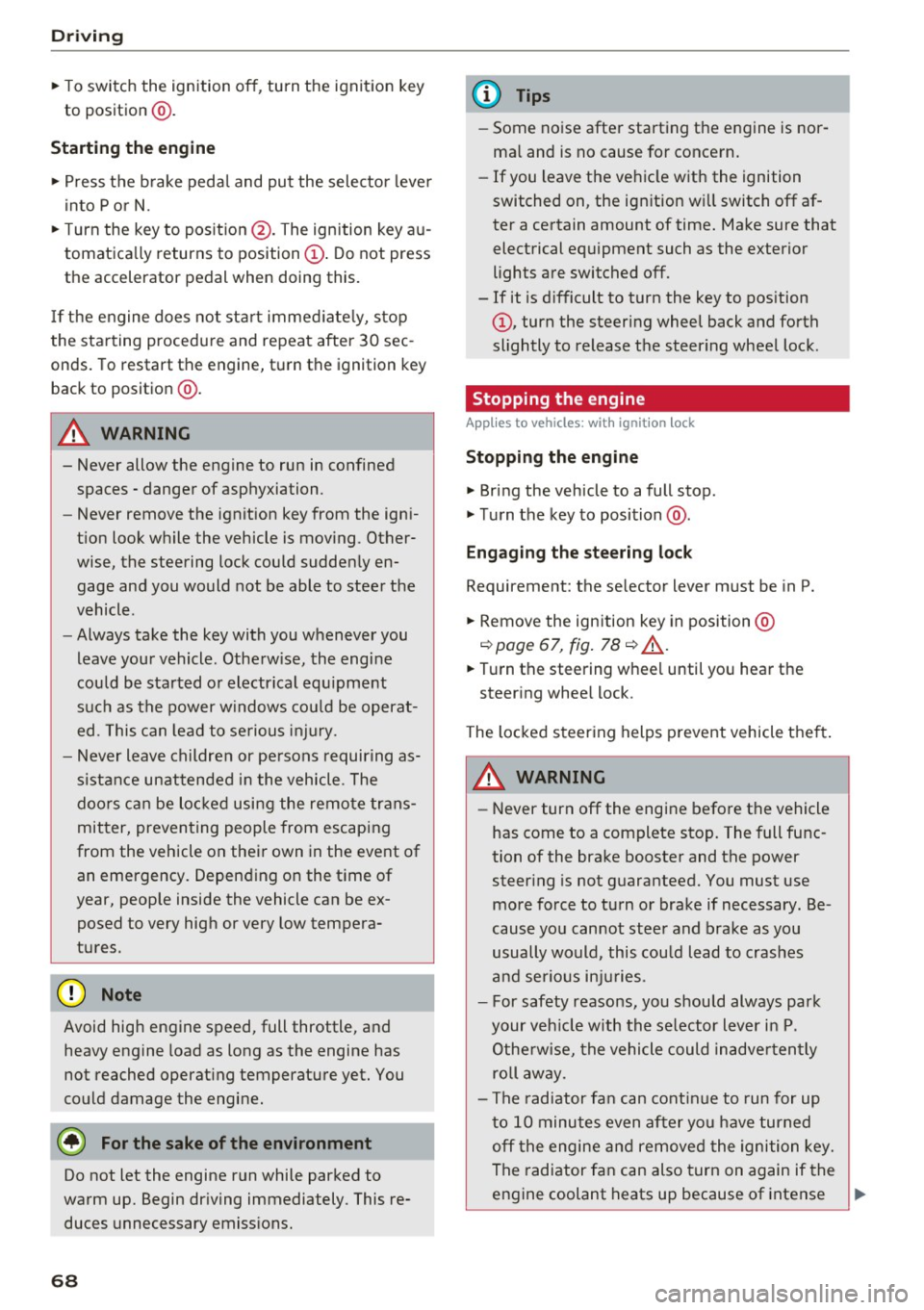
Driving
"'T o switch the ignition off, turn the ignition key
to position @.
Starting the engine
"' Press the b rake pedal and put the selector leve r
in to P or N.
"'T urn the key to pos it ion @. The ignition key au
tomatica lly returns to position
(I) . Do not press
the accelerator pedal when doing this.
If the engine does not sta rt immed iate ly, stop
the starting procedure and repeat after 30 sec
onds. To restart the engine, turn the ignition key
back to position @.
A WARNING
- Never allow the engine to run in confined
spaces -danger of asp hyxiation .
-
-Never remove the ignit ion key from the ign i
t ion look while the vehicle is moving . Other
wise , the steering lock cou ld sudden ly en
gage and you would not be able to stee r the
vehicle .
- Always take the key with you whenever you
leave your vehicle . Otherw ise, the engi ne
cou ld be sta rted o r electrical equ ipment
s uch as the power w indows co uld be operat
ed . This can lead to se rious i nju ry.
- Never leave children or pe rsons requiring as
sistance unattended i n the vehicle . The
doo rs c an be lo cked usi ng the remote trans
mit ter, preven ting people from escapin g
from the vehicle on thei r own in the event of
an emergency. Depending on the time of
year, people inside the vehicle can be ex
posed to very hig h or very low tempera
tures.
(D Note
Avoid high engine speed, full throttle, and heavy engine load as long as the engine has
not reached operat ing temperature yet. You
could damage the engi ne.
@ For the sake of the environment
Do not let the engine run while parked to
warm up. Begin dr iving immediately . This re
duces unnecessary emiss ions.
68
(D Tips
- Some noise after start ing the engine is nor
ma l and is no cause for concern.
- If you leave the ve hicle w ith the ignition
switched on, the ign ition wi ll switch off af
ter a certain amount of time. Make sure that
electrical equipment such as the exterior
lights are switched off.
- If it is d ifficult to turn the key to pos ition
(D , turn the steering wheel back and forth
slightly to release the steering wheel lock.
Stopping the engine
App lies to vehicles: with ignition lock
Stopping the engine
"' Bring the vehicle to a full stop .
"'T urn the key to posi tion @.
Engag ing the steering lock
Requi rement: the se lector lever must be in P.
"' Remove the ignition key in position @
c::> page 67, fig. 78 c::> &_ .
"'Tur n the steering whee l until you hear the
steer ing whee l lock .
The locke d steer ing helps prevent vehicle the ft.
A WARNING
-Never turn off the engine before the vehicle
has come to a complete stop. The full func
tion of the brake booster and the power
steer ing is not guaranteed. You must use
more force to turn or brake if necessary. Be
cause you cannot stee r and brake as you
usually would, this cou ld lead to crashes
a nd se rio us in juries.
- For safety reasons, yo u sh ould always park
your veh icle w ith the se lector lever i n P.
Othe rwise, the vehicle could inadve rten tly
roll aw ay.
- The rad iator fa n can cont in u e to run for up
t o 10 minutes even af ter yo u have turned
off the engine an d remove d the igni tion key.
The rad iator fan can also turn on again if the
eng ine coolant heats up because of intense .,._
Page 72 of 252
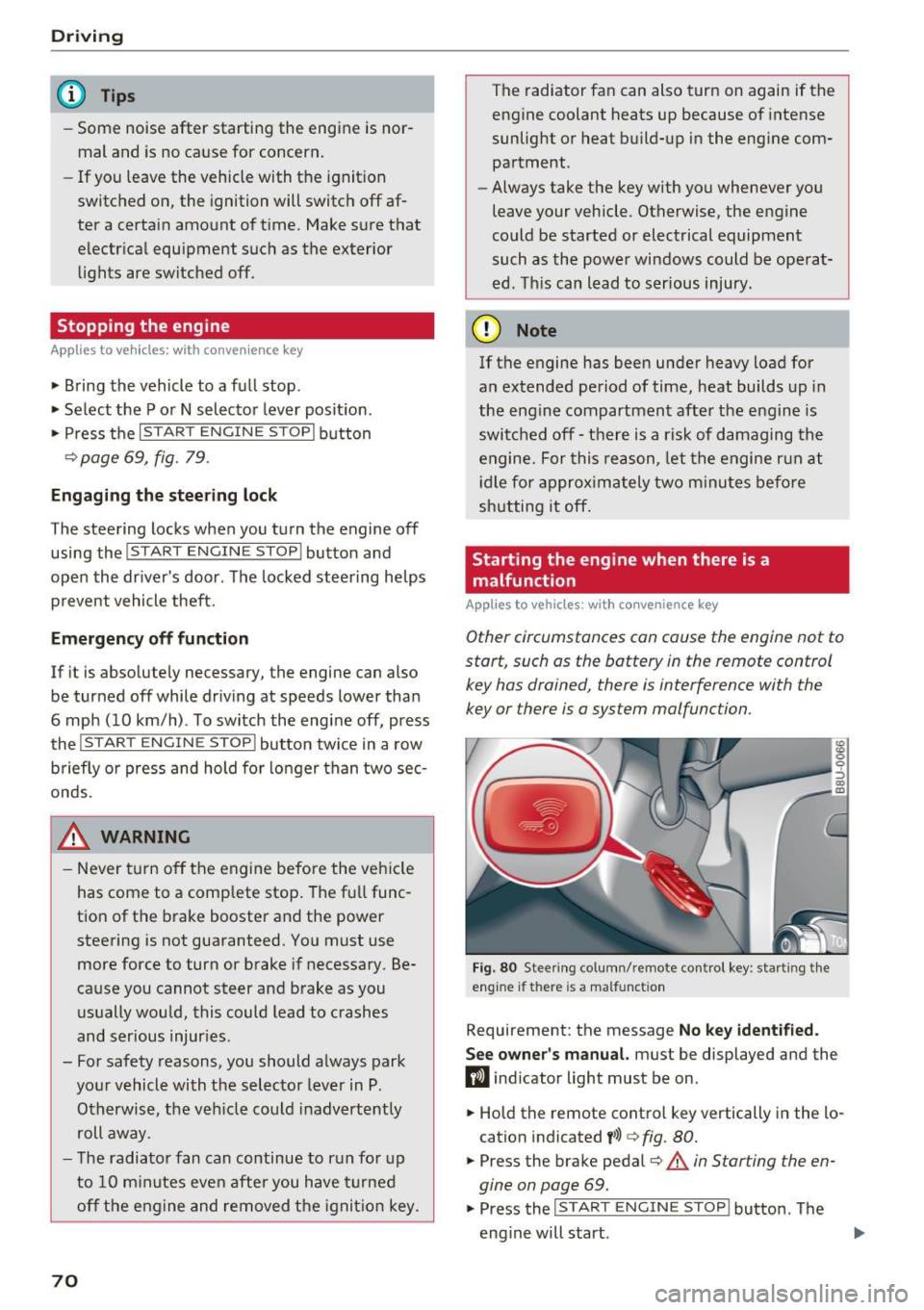
Driving
@ Tips
-Some noise after starting the engine is nor
mal and is no cause for concern.
- If you leave the vehicle with t he ignit ion
switched on, the ignition will switc h off af
ter a certain amount of time . Make sure that
electr ica l equipment suc h as the exterior
lights are switched off.
Stopping the engine
Appl ies to veh icles: w ith conve nien ce key
• Bring the vehicle to a full stop.
• Select the P or N selector lever position .
• Press the
I S TAR T ENGIN E STO PI button
¢ page 69, fig. 79.
Engaging the steering lock
The steering locks when you turn the engine off
using the
I START ENGINE STOP! button a nd
open the driver's door . The locked steering helps
p revent vehicle theft.
Emergency off function
If it is absolutely necessary, the engine can also
be turned off while driving at speeds lower than
6 mph (10 km/h) . To switch the engine off, press
the
I START ENGINE STOPI button twice in a row
briefly o r press and hold for longer than two sec
onds.
_& WARNING
- Never turn off the engine before the veh icle
has come to a comp lete stop . The full func
tion of the brake booster and the power
steering is not guaranteed. You must use more force to turn or brake if necessary. Be
cause you cannot steer and brake as you
usually would, this could lead to crashes
and serious injuries.
- For safety reasons, you should always park
yo ur vehicle with the selecto r lever in P .
Otherwise, the vehicle could inadvertently
roll away .
- The radiator fan can continue to r un for up
to 10 minutes even after you have turned
off the engine and removed the ignit ion key.
70
The radiator fan can also turn on again if the
engine coolant heats up because of intense
sunlight or heat build-up in the engine com
partment .
- Always take the key with you whenever you
leave your vehicle . Otherwise, the engine
could be started or electrical equipment
such as the power windows could be operat
ed. This can lead to serious injury.
(D Note
If the engine has been under heavy load for
an extended period of time, heat builds up in
the eng ine compartment after the engine is
switched off -there is a risk of damaging the
engine. For this reason, let the engine r un at
idle for approxi mately two minutes before
shutting it off.
Starting the engine when there is a
malfunction
App lies to vehicles: wit h co nvenience key
Other circumstances can cause the engine not to
start, such as the battery in the remote control
key has drained , there is interference with the
key or there is a system malfunction .
Fig. 80 Stee ring co lumn/ remo te cont rol key : sta rting t he
engine if th ere is a malfunct ion
Requirement: the message No key identified.
See owner's
manual. must be displayed and the
fl ind icator light must be on .
• Hold the remote control key vertically in the lo
cation indicated
t>>) ¢ fig. 80.
• Press the brake pedal¢.&. in Starting the en
gine on page
69.
• Press the ~IS_T_A_R_T_ E_N_ G_ I_ N_ E ~ s=T ~O ~ P~ I button. The
eng ine will start .
Page 168 of 252
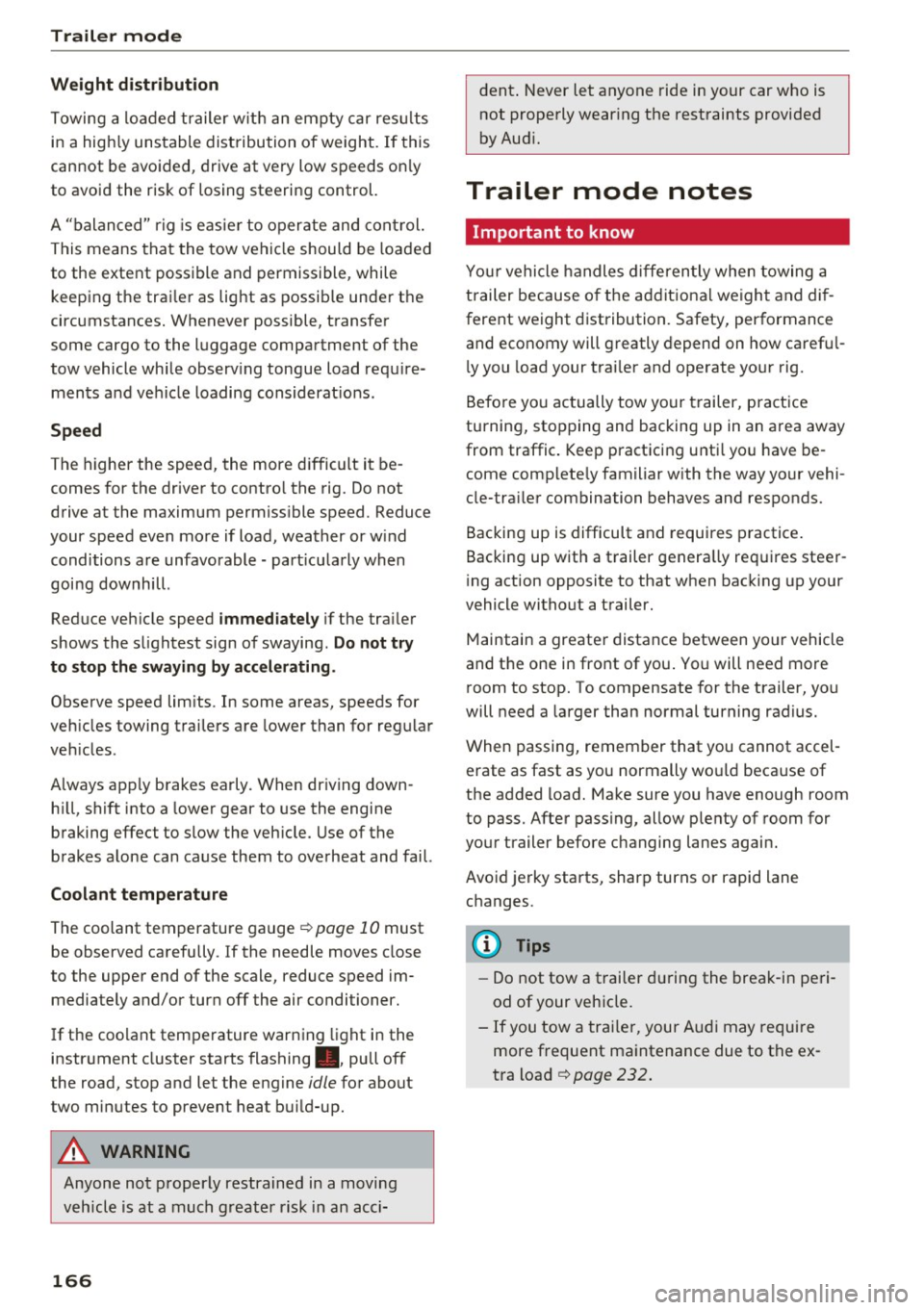
Trailer mod e
Weight d istribution
Towing a loaded trailer with an empty car res ults
in a high ly unstable distribution of weight . If this
cannot be avoided, drive at very low speeds on ly
to avoid the risk of losing steering control.
A "balanced" rig is easie r to operate and con trol.
This means that the tow vehicle should be loaded
to the extent possible and permissible, while
keeping the trai le r as light as possib le under the
circumstances. Whenever possible, transfer
some cargo to the luggage compartment of the
tow vehicle while observ ing tongue load requ ire
ments and vehicle loading considerat ions.
Spee d
The higher the speed, the more difficult it be
comes for the driver to contro l the rig. Do not
drive at the maximum permiss ible speed. Reduce
your speed even more if load, weather or w ind
conditions are unfavorable - part icularly when
goi ng downhill.
Reduce veh icle speed
immediatel y if the tra iler
shows the slightest sign of swaying .
Do not try
to stop the sway ing by acc ele rating .
Observe speed lim its. In some areas, speeds for
veh icles towing trailers are lower than for regular
ve hicles.
A lways app ly brakes early. When driving down
h ill, shift into a lower gear to use the engine
braking effect to slow the veh icle. Use of the
brakes alone can cause them to overheat and fail.
Coolant temp era ture
The coolant temperature gauge¢ page 10 must
be observed carefully. If the needle moves close
to the upper end of the scale, reduce speed im mediately and/or turn off the air conditioner.
If the coo lant temperature warning light in the
instr ument cluster starts flashing., pull off
the road, stop and let the engine
idle for about
two minutes to prevent heat bu ild-up.
A WARNING
Anyone not proper ly restrained in a moving
vehicle is at a much greater risk in an acci-
166
-
dent . Never let anyone ride in your car who is
not properly wear ing the restraints provided
by Audi.
Trailer mode notes
Important to know
You r vehicle handles differently when towing a
trailer because o f th e additiona l weight and dif
ferent weight distribution. Safety, performance
and economy will g reatly depend on how carefu l
l y you load your trai ler and operate your rig.
Before yo u actually tow your trailer, pract ice
turning, stopping and backing up in an area away
from traffic . Keep practicing unti l you have be
come complete ly familiar w ith the way your vehi
cle-tra iler combination behaves and responds.
Backing up is difficult and requires practice .
Backing up with a trailer genera lly requires steer
ing action opposite to that when backing up your
vehicle without a trailer.
Maintain a greater distance between your vehicle
and the one in fro nt of you . You will need more
room to stop. To compensate for the trailer, you
will need a larger than normal turning radius.
When passing, remember that you cannot accel erate as fast as you normally wo uld beca use of
the added load. Make sure you have enough room
to pass. After passing, allow p lenty of room for
your trailer before changing lanes again.
Avoid jerky starts, sharp turns or rapid lane
changes.
@ Tips
- Do not tow a trailer du ring the break-in peri
od of your vehicle.
- If you tow a trai le r, your Au di may requi re
more frequent maintenance due to the ex
t ra load ¢
page 232.
Page 179 of 252
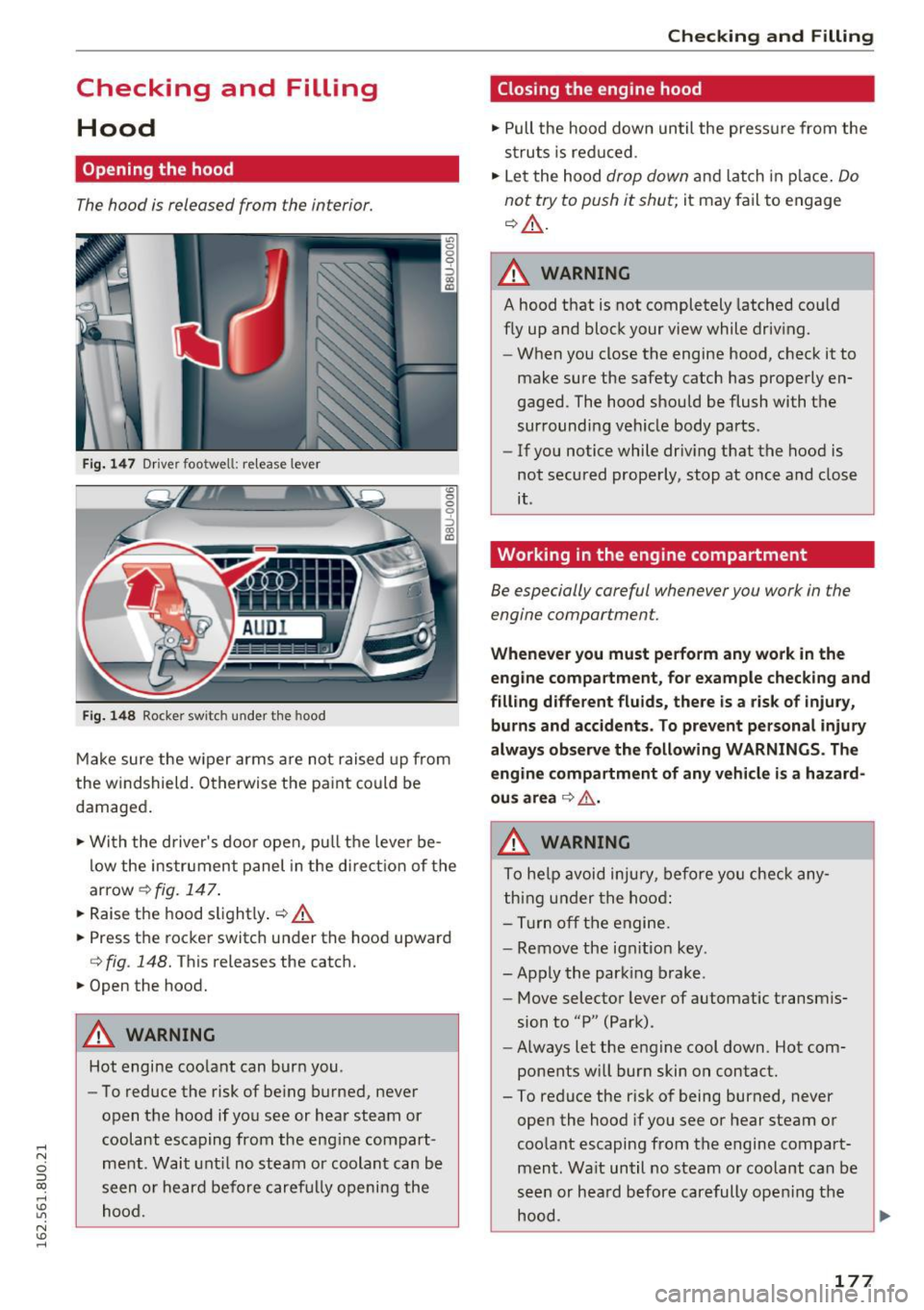
.... N
c:i ::J CX)
.... I.Cl U"I
N I.Cl ......
Checking and Filling Hood
Opening the hood
The hood is released from the interior.
Fig. 147 Driver footwell: release lever
Fig. 14 8 Rocke r switch under t he hood
<0 0 0
0
::,
"' CD
Make sure the w iper arms are not raised up from
the w indshield. O therwise the paint coul d be
damaged .
.,. Wi th the d river's doo r open, p ull th e leve r be
l ow the ins trument panel in the direct io n of the
arrow¢
fig. 1 47.
.,. Raise the hood s lightly . q &.
.,. Press t he roc ker switc h under the hood upward
Q fig. 148. This releases the catch.
.,. Open the hood.
A WARNING
Hot engine coolant can burn you.
- To reduce the risk of be ing burned, never
open t he hood if you see or hear steam or
coolant escaping from the eng ine compart
me nt. Wait unt il no steam or coolant can be
seen o r he ard before caref ully opening the
hood.
Checking and Filling
Closing the engine hood
., Pull the hood down until the press ure from the
s tr uts is red uced .
.,. Le t the hood
drop down and lat ch in p lace . Do
not try to push it shut;
it may fail to engage
q &_ .
A WARNING
A hood that is not completely latched co uld
fly up and block your view while driv ing.
- When you close the engine hood, check it to
make sure the safety catch has prope rly en
gaged. The hood should be flush with th e
sur rounding veh icle body parts.
- If you notice while driv ing that the hood is
not secured prope rly, stop at once and close
it .
Working in the engine compartment
Be especially careful whenever you work in the
engine compartment.
-
Whenever you must pe rform any work in the
eng ine compartment , for e xample check ing and
filling diff erent fluids, there is a ris k of injury,
burns and accidents. To prevent personal injury
always ob serv e the following WARNINGS . Th e
engine compartment of any veh icle is a hazard
ou s area
q .&. .
A WARNING
To he lp avoid injury, before yo u check any
t hing under the hoo d:
- Turn off the engi ne .
- Remove the ign ition key.
- Apply the park ing brake .
- Move selector lever of automatic transmis-
sion to "P" (Park).
- Always let the engine cool down. Hot com
ponents w ill bur n skin on contact.
-
-To reduce the risk of being burned, never
open the hood if you see or hear steam or
coo lant escaping from the engine compart
ment. Wa it until no steam o r coolant can be
seen or hea rd before carefully opening the
hood.
177
Page 180 of 252
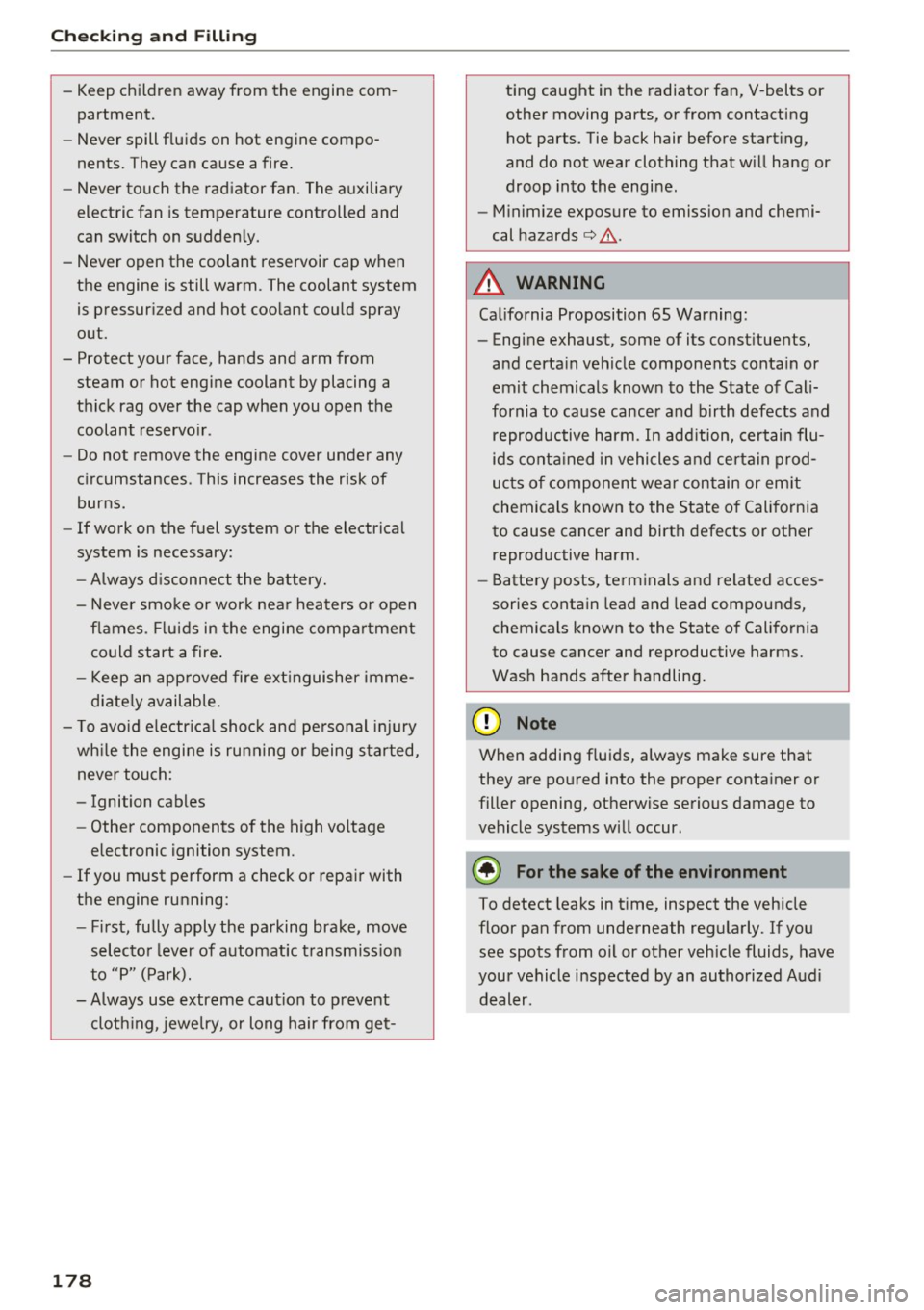
Checking and Filling
-Keep children away from the engine com
partment.
- Never spill fluids on hot engine compo
nents. They can cause a fire.
- Never touch the radiator fan. The auxiliary
electric fan is temperature controlled and
can switch on suddenly.
- Never open the coolant reservoir cap when
the engine is still warm. The coolant system
is pressurized and hot coolant could spray
out.
- Protect your face, hands and arm from steam or hot engine coolant by placing a
thick rag over the cap when you open the
coolant reservoir .
- Do not remove the engine cover under any
circumstances. This increases the risk of
burns .
- If work on the fuel system or the electrical
system is necessary:
-Always disconnect the battery.
- Never smoke or work near heaters or open
flames. Fluids in the engine compartment
could start a fire.
- Keep an approved fire extinguisher imme
diately available.
- To avoid electrical shock and personal injury
while the engine is running or being started,
never touch:
- Ignition cables
- Other components of the high voltage
electronic ignition system.
- If you must perform a check or repair with
the engine running:
- First, fully apply the parking brake, move
selector lever of automatic transmission
to "P" (Park).
- Always use extreme caution to prevent
clothing, jewelry, or long hair from get-
178
ting caught in the radiator fan, V-belts or
other moving parts, or from contacting
hot parts. Tie back hair before starting,
and do not wear clothing that will hang or
droop into the engine.
- Minimize exposure to emission and chemi
cal hazards
c::> & .
A WARNING
California Proposition 65 Warning:
- Engine exhaust, some of its constituents,
and certain vehicle components contain or
emit chemicals known to the State of Cali
fornia to cause cancer and birth defects and
reproductive harm. In addition, certain flu
ids contained in vehicles and certain prod
ucts of component wear contain or emit
chemicals known to the State of California
to cause cancer and birth defects or other
reproductive harm .
- Battery posts, terminals and related acces
sories contain lead and lead compounds,
chemicals known to the State of California
to cause cancer and reproductive harms.
Wash hands after handling.
([) Note
When adding fluids, always make sure that
they are poured into the proper container or
filler opening, otherwise serious damage to
vehicle systems will occur.
@ For the sake of the environment
To detect leaks in time, inspect the vehicle
floor pan from underneath regularly. If you
see spots from oil or other vehicle fluids, have
your vehicle inspected by an authorized Audi dealer .
Page 181 of 252
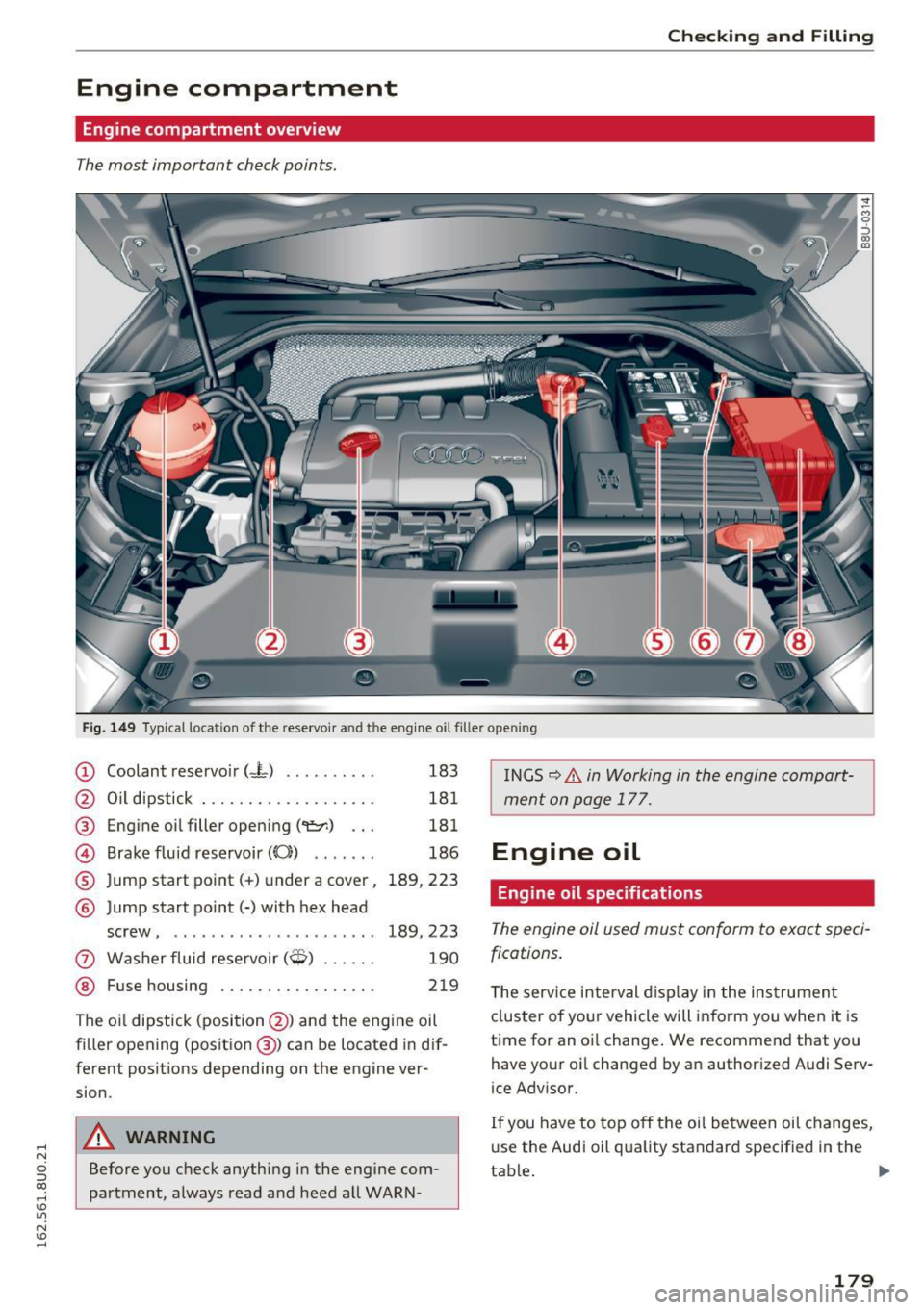
.... N
c:i ::J CX)
.... I.Cl U"I
N I.Cl ......
Checking and Filling
Engine compartment
Engine compartment overview
The most important check points.
Fig. 149 Typical location of the reservoir a nd the engine o il fil ler ope ning
(D Coolant reservoir (-L) . . . . . . . . . . 183
@ Oil dipstick . . . . . . . . . . . . . . . . . . . 181
@ Engine oil filler opening ('1!::r.) . . . 181
@ Brake fluid reservoir (0) . . . . . . . 186
® Jump start point(+) under a cover, 189, 223
® Jump start point(-) with hex head
screw, . . . . . . . . . . . . . . . . . . . . . .
189, 223
0 Washer fluid reservoir($) . . . . . . 190
@ Fuse housing . . . . . . . . . . . . . . . . . 219
The oil dipstick (position @) and the engine oil
filler opening (position @) can be located in dif
ferent positions depending on the engine ver
sion.
A WARNING
Before you check anything in the engine com
partment, always read and heed all WARN- INGS
9 .&. in Working in the engine
compart
ment on page 177.
Engine oil
Engine oil specifications
The engine oil used must conform to exact speci
fications.
T he serv ice interval d isplay in the instrument
cluster of your vehicle will inform you when it is
time for an oil change . We recommend that you
have your oil changed by an authorized Audi Serv
ice Advisor.
If you have to top off the oil between oil changes,
us e the Audi oil quality standard specified in the
tab~ .
~
179